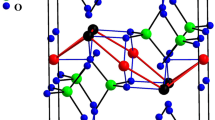Abstract
We measured the nuclear quadrupole resonance (NQR) of the solid solutions of NaClO3-KClO3 in the range of concentrations from 0 to 100% molar of KClO3 in (NaClO3 + + KClO3). The thermal diagram of the measured samples showed, that the solubility of the components in each other is limited. It is shown that up to 88·6% molar of KlCO3 it is possible to identify signals at a frequency which almost exactly corresponds to the NQR frequency of NaClO3, from this concentration the signals belong to the NQR frequency of KClO3. At the same time the width of the line shows anomalies in samples containing up to 10% KClO3 or up to 10% NaClO3. Broadening of the NQR line to the value 35 kHz in this region was interpreted as a result of prevalence of the “size-effect”, when the solid solution consists of a mixed crystal of one of the components with such a number of cations of the other component, which is sufficient to produce a chaotic order around the resonanting Cl35 nucleus and such alterations of the electrical field gradient, that they will widen the line.
We have also interpreted the deviations of the resonance frequency and linewidth corresponding to the monocrystalline, polycrystalline and melted modifications of the pure NaClO3 and KClO3 components.
The dependence of the molar magnetic susceptibility of the solid solutions on the concentration of KClO3 in NaClO3 + KClO3 is not linear, it has a peak at the concentration that belongs to the eutectic state, when the chaotic order of the ions Na1+, K1+, (ClO3 1− around any of them is most perfect. At this concentration Van Vleck's polarization paramagnetism is minimum and because it is positive, the total negative value of susceptibility of the material is maximum.
Similar content being viewed by others
References
Duchesne J., Monfils A., Compt. rend.238 (1954), 1801.
Dean C., Chem. Phys.23 (1955), 1734; Phys. Rev.96 (1954), 1053.
Dean C., Pound R. V., J. Chem. Phys.20 (1952), 195.
Segel S. L., Lutz B. C., Phys. Rev.98 (1955), 1183.
Cohen M. H., Reif F., Solid State Phys.5 (1957), 321.
Reif F., Phys. Rev.100 (1955), 1597.
Bloembergen N., Rept. Conf. on Defect in Crystalline Solids in Bristol. The Phys. Soc., London 1955, p. 1.
Vogt E., Physikalische Eigenschaften der Metalle, Bd. I. Akad. Verlag, Leipzig 1958, p. 238–287.
Bhatnagar S. S., Kapur P. L., J. Indian Chem. Soc.9 (1952), 347.
Rákoš M., Čs. čas. fys.A 9 (1959), 368.
Dorfman J. G., Diamagnetizm i chimičeskaja svjaz. GLFML, Moskva 1961, p. 76–78.
Varga Z., Rákoš M., Czech. J. Phys.B 25 (1975), 1197.
Rákoš M., Základy meraní slabomagnetických látok. Vydav. SAV, Bratislava 1965, p. 36.
Van Vleck J. H., The Theory of Electric and Magnetic Susceptibilities. Oxford Univ. Press (reprint), London 1959.
Skokanová Z., Rákoš M., Czech. J. Phys.B 21 (1971), 983.
Hodgman Ch. D.. etal., Handbook of Chemistry and Physics. Chemical Rubber Publ. Cr., Cleveland-Ohio 1955, p. 566, 592.
Das T. P., Hahn E. L., Nuclear Quadrupole Resonance Spectroscopy. Academic Press Inc., New York-London 1958, p. 103.
Remy H., Anorganická chemie I (translation). Státní nakladatelství technické literatury, Praha 1961, p. 785.
Brdička R., Základy fysikální chemie. Přírodovědecké vydavatelství, Praha 1952, p. 191.
Zeldes H., Livingston R., J. Chem. Phys. 26 (1957), 351.
See [17], p. 16.
Wang T. C., Phys. Rev.99 (1955), 566.
Ross M. W.; Inorg. Chem.3 (1964), 199.
Author information
Authors and Affiliations
Rights and permissions
About this article
Cite this article
Haleš, J., Rákoš, M. & Lašanda, J. NQR and magnetic characteristics of the solid solution of NaClO3-KClO3 . Czech J Phys 26, 936–944 (1976). https://doi.org/10.1007/BF01589697
Received:
Issue Date:
DOI: https://doi.org/10.1007/BF01589697



